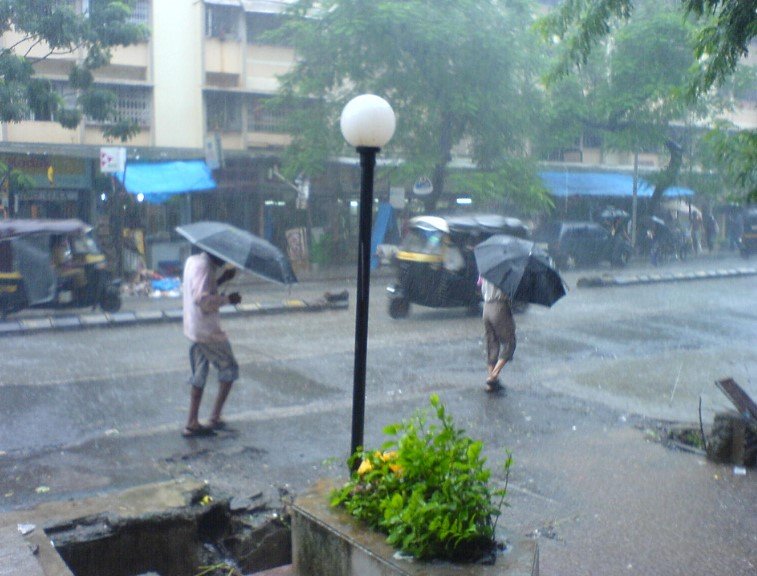Mumbai woke up soaked, and by midday Monday, the city was swimming in records. The monsoon has officially arrived—and it’s come thundering in far earlier than anyone expected.
Some parts of Mumbai recorded more than 200 mm of rain in just a few hours between Sunday midnight and Monday afternoon, leading the India Meteorological Department (IMD) to sound the highest-level “red alert.” The streets flooded, the trains slowed, and even the Metro was forced to halt operations in parts of the city.
Earliest Monsoon in Over Seven Decades
This isn’t just another wet start to the season. It’s historic.
The southwest monsoon typically reaches Mumbai around June 11. But this year, it’s nearly two weeks early. Not since 1949 has the city seen rains this soon. The IMD, known for erring on the side of caution, confirmed the earliest recorded onset in at least 75 years.
In just 11 hours—from midnight to 11:30 am—parts of South Mumbai saw downpours strong enough to flood low-lying areas and stall vehicles. Byculla, Colaba, Nariman Point—all were drenched.
One official from IMD Mumbai said, “We’re seeing a dramatic shift in timing and intensity. It’s not just early, it’s strong.”
Rainfall Figures Stun Residents
Numbers tell the story better than words sometimes.
By Monday morning, BMC’s automated weather stations logged some staggering figures:
-
Nariman Point: 252 mm
-
Byculla: 213 mm
-
Colaba: 207 mm
-
Do Taki: 202 mm
-
Chandanwadi & Marine Lines: 180 mm
-
Memonwada: 183 mm
-
Worli: 171 mm
It wasn’t just a downpour—it was a wall of water.
In fact, any rainfall over 204.5 mm in 24 hours qualifies as “extremely heavy” by IMD standards. Several areas crossed that mark by noon. And the skies weren’t done yet.

Streets Flood, Trains Crawl, Metro Halts
Mumbai knows rain. But this one was a bit much, even for the city’s famously stoic commuters.
Roads turned into rivers across major pockets of the city. The Dadar TT flyover stretch, a chronic flood spot, was underwater by morning rush hour. And it didn’t stop there.
One of the city’s Metro lines had to temporarily suspend service when water entered an underground station. That brought part of the suburban transport system to a standstill.
Suburban train services—the city’s lifeline—slowed down on the Western and Central lines. Local buses had to reroute. Motorists, meanwhile, were stuck for hours.
One sentence here: It was chaos in slow motion.
Red Alert Triggers Emergency Measures
With the deluge continuing and forecast looking grim, the IMD raised the alert level from orange to red—its most serious warning.
The warning covered Mumbai, Thane, Raigad, and Ratnagiri. The IMD’s red alert signals very heavy to extremely heavy rainfall, along with gusty winds and possible thunderstorms.
BMC sprang into action. Emergency response teams were mobilized across flood-prone zones. Control rooms ran at full capacity.
In a press note, a BMC spokesperson stated that over 100 pumping stations were operating to prevent water accumulation. “We’re monitoring high tide timings closely. If rain aligns with high tide, we’re in for serious waterlogging,” the official warned.
Climate Signals or One-Off Event?
This isn’t just about early rain. There are bigger questions swirling.
Meteorologists and climate scientists have flagged how the Arabian Sea is heating up faster than usual. That leads to stronger, earlier monsoon surges. A warming Indian Ocean is throwing long-standing monsoon patterns off-kilter.
Recent studies from the Indian Institute of Tropical Meteorology suggest pre-monsoon rain activity is becoming more erratic. Monsoons are arriving early one year and late the next. It’s a pattern, but a messy one.
This year, the monsoon hit Kerala on May 25—six days ahead of the normal schedule. Now, Mumbai’s early arrival just two days later adds weight to those concerns.
Local Impact: From Office Rush to Daily Wages
Behind the flood maps and weather alerts lie people—trying to go about their day.
Rickshaw drivers lined up near Grant Road Station said they had to abandon routes due to waterlogged lanes. One of them, Asif, shared, “We lose half the day’s income when it rains like this. Who’s paying for that?”
Daily wage laborers, too, were hit hard. With major construction work halted temporarily in parts of the city, many were left waiting under shelters.
Meanwhile, office-goers did what Mumbaikars do best: wade through water, often literally. Social media lit up with videos of people helping push broken-down autos, barefoot walkers crossing submerged footpaths, and even a few kids playing cricket in the rain.
